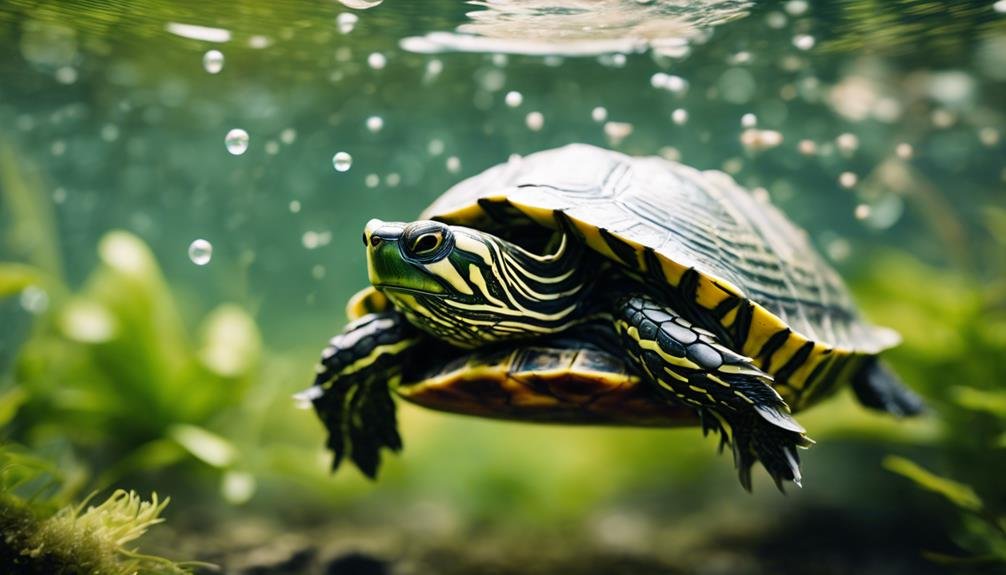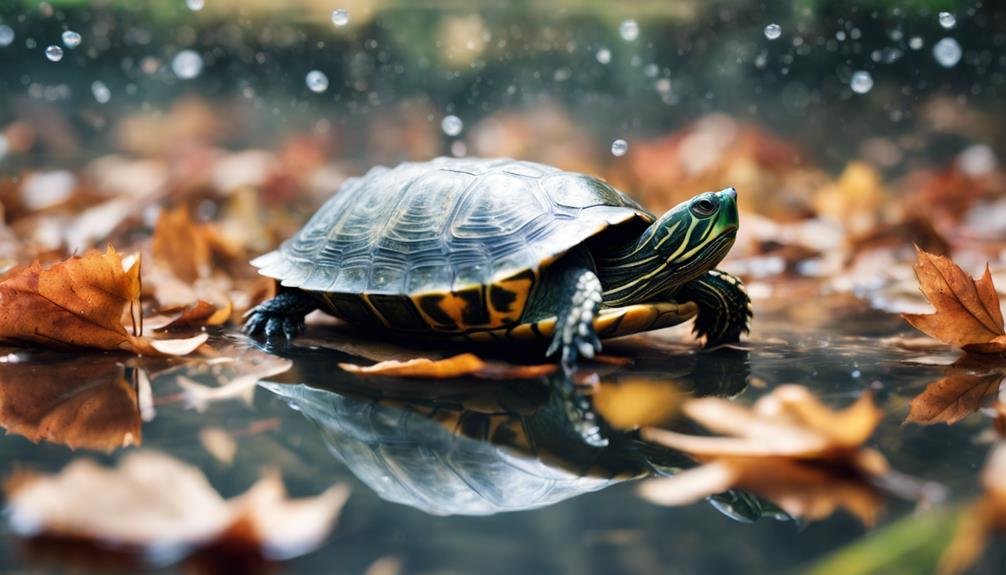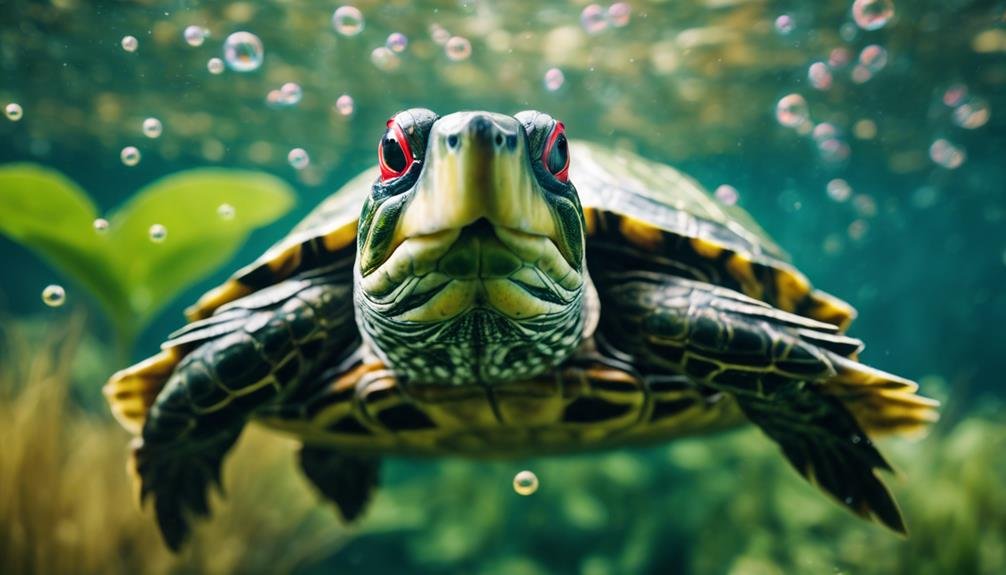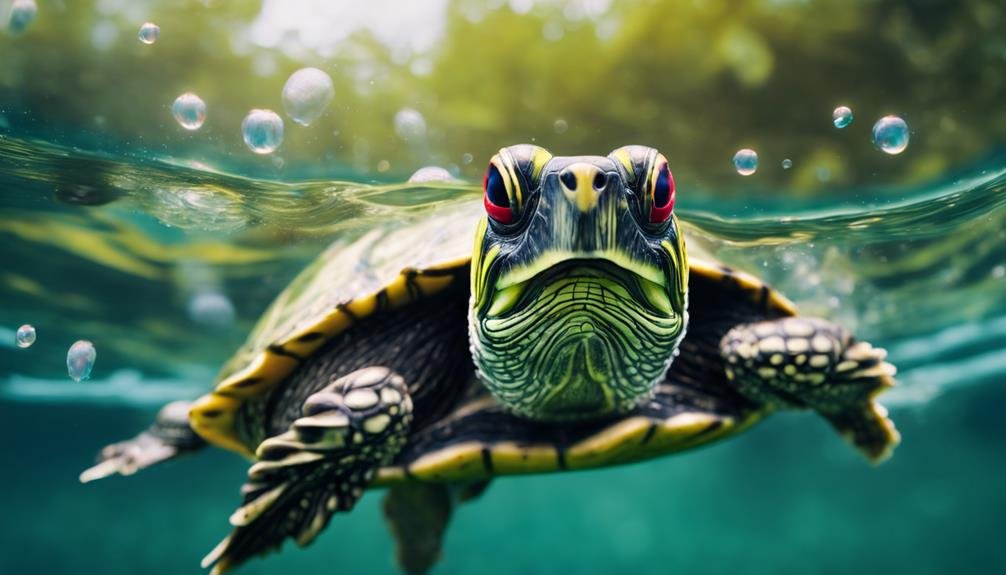You might wonder how red-eared sliders manage to spend so much time submerged without surfacing for air. The secret lies in a fascinating process known as cloacal respiration, which allows these turtles to extract oxygen directly from the water. This adaptation is vital for their survival, especially during colder months when their metabolic rate slows down. However, while it sounds like they have an underwater superpower, there are limitations to this ability that are essential to understand. Let’s explore the intricacies of how red-eared sliders breathe underwater, uncovering the myths and revealing the science behind their aquatic endurance.
Key Takeaways
- Red-eared sliders use cloacal respiration to extract oxygen directly from water.
- They can stay submerged and breathe underwater through cloacal respiration.
- Their ability to hold their breath ranges from 15 to 30 minutes.
- Cooler water temperatures extend their underwater breath-holding capacity.
- Cloacal respiration is especially vital during brumation in cold water.
Understanding Respiration
Respiration in red-eared sliders is a fascinating process, primarily relying on their nostrils for oxygen but also utilizing a unique method called cloacal respiration to extract oxygen directly from water. As a turtle owner, it’s intriguing to learn that your slider has the ability to breathe underwater, albeit in a limited and inefficient manner. Through cloacal respiration, bursae located in the cloaca absorb oxygen from the water, allowing these turtles a form of aquatic respiration. This process involves the direct extraction of oxygen from water, which supplements their oxygen intake when submerged.
However, it’s important to remember that this method of breathing underwater isn’t sufficient to meet all their oxygen needs. The efficiency of cloacal respiration is quite low, meaning your slider can’t rely on it entirely for its oxygen supply. They still need to come up to the surface and use their nostrils to breathe air periodically. Without accessing the air above water, sliders would face the risk of suffocation. This unique blend of respiratory strategies underscores the adaptability of red-eared sliders, but also their reliance on both aquatic and terrestrial environments to survive.
Breath-Holding Capacity
You might wonder just how long red-eared sliders can stay submerged without coming up for air. They’re capable of holding their breath for 15 to 30 minutes, with cooler water greatly extending this time due to their reduced oxygen consumption.
However, there are limits to this ability, and understanding these can be vital for their survival if they’re ever trapped underwater.
Duration Underwater
Red eared sliders can impressively hold their breath underwater for anywhere between 15 to 30 minutes, depending on conditions such as water temperature. This remarkable breath-holding ability allows them to remain submerged for extended periods, optimizing their chances of survival in aquatic environments.
Cooler water temperatures greatly extend their underwater endurance by reducing their metabolic rate, which in turn decreases their oxygen requirements. In the unfortunate event they stay under longer than they can manage and seem to have drowned, there’s still hope. These turtles can often be resuscitated with proper care, highlighting the resilience of red-eared sliders.
After such incidents, it’s essential they’re examined by a reptile vet to make sure they recover fully and maintain their health.
Limitations of Breath-Holding
While turtles like red-eared sliders can stay submerged for up to 30 minutes, it’s crucial to understand their breath-holding capacity has limitations, particularly in varying water temperatures. You should know that the cooler the water, the longer they can survive underwater. This is because cooler temperatures slow down their metabolism, reducing the need for oxygen.
However, if they’re trapped underwater beyond their capacity to hold their breath, survival heavily depends on temperature. Surprisingly, even if they appear to have drowned, they can sometimes be revived. But don’t take this lightly; a revived turtle must be seen by a reptile vet immediately for follow-up care. This ensures they’re thoroughly checked and treated for any potential complications from their underwater ordeal.
Cloacal Respiration Explained


You might wonder how red eared sliders manage to stay underwater for so long without coming up for air.
They use a fascinating process called cloacal respiration, where they absorb oxygen directly from the water through their cloaca.
This method is essential for their survival, especially in environments where oxygen levels are low.
How Cloacal Respiration Works
Cloacal respiration, an extraordinary adaptation, allows red eared sliders to absorb oxygen directly through blood vessels in their cloaca, enabling them to breathe underwater.
This unique process empowers these turtles to extract oxygen from the surrounding water, a crucial ability for surviving in low-oxygen environments or when undergoing brumation.
The specialized blood vessels in the cloaca are key to this oxygen extraction method. They facilitate the exchange of oxygen and waste products, making cloacal respiration an essential adaptation for underwater breathing, particularly in cold water conditions.
Importance for Red Eared Sliders
For red eared sliders, mastering the art of cloacal respiration is vital for their survival, especially in environments where oxygen levels are low. This unique form of underwater breathing allows them to thrive in low-oxygen environments, ensuring they don’t just survive but flourish. Through the blood vessels in their cloaca, they can extract oxygen directly from the water, a critical adaptation for life in cold water and during brumation periods.
Consider these points to truly appreciate the significance of cloacal respiration:
- It’s a lifeline in low-oxygen environments, where traditional breathing methods fall short.
- During brumation, when metabolic rates drop, cloacal respiration safeguards their survival without needing to surface for air.
- In cold water, where other creatures might struggle, they can maintain their bodily functions efficiently, thanks to this unique adaptation.
Myths About Underwater Breathing
Despite popular belief, red-eared sliders can’t breathe underwater like fish, needing to surface for air to meet their metabolic requirements. Many people think these turtles can stay submerged indefinitely, absorbing oxygen directly from the water. However, this is a myth. Red-eared sliders, like all turtles, rely on their lungs to breathe air. They’re equipped to hold their breath for significant periods while diving or resting underwater, but this doesn’t equate to breathing water.
The confusion might stem from observations of red-eared sliders spending a lot of time submerged, only occasionally popping up for air. Yet, their ability to remain underwater for extended periods is an indication of their efficient use of stored oxygen, not a capability to extract it from the water. They must surface to refill their lungs and avoid suffocation.
Understanding that these creatures can’t breathe underwater highlights the significance of providing them with an environment that allows easy access to the surface. It’s essential for their well-being and survival, ensuring they meet their oxygen needs without stress or strain.
Brumation and Oxygen Absorption


Fascinatingly, during the colder months, red-eared sliders enter a state known as brumation, where they can absorb oxygen directly through blood vessels in their cloaca to survive underwater for extended periods. This remarkable adaptation isn’t just a survival tactic; it’s a demonstration of the resilience and ingenuity of these creatures. As you marvel at their ability to thrive in conditions that would be inhospitable to many, consider the following:
- Brumation allows red-eared sliders to rest at the bottom of water bodies, immersing themselves in a near-dormant state that’s akin to hibernation. This period of rest is vital for their survival, reducing their need for frequent oxygen intake.
- Cloacal respiration is a unique method of oxygen absorption, enabling these turtles to draw oxygen from the water through their cloaca. This process supports their life in cold, oxygen-poor environments.
- Significant decreases in heart rate and metabolism during brumation highlight their incredible energy conservation strategies. These physiological changes allow red-eared sliders to minimize their energy expenditure, ensuring they emerge from brumation ready to thrive once more.
Through cloacal respiration, brumation, and strategic energy conservation, red-eared sliders exemplify nature’s adaptability, turning the harsh winter months into a time of quiet survival and resilience.
Risks of Drowning
Although red-eared sliders possess unique adaptations for underwater survival, they’re not immune to the risk of drowning if they can’t access the surface to breathe. These turtles need to surface regularly to fill their lungs with air; without this ability, they face a serious suffocation and drowning risk. It’s crucial to understand that while they’re adept at holding their breath for extended periods, they’re not capable of breathing underwater in the same way fish do.
Blockages or physical obstructions in their aquatic environment can prevent red-eared sliders from reaching the surface, greatly increasing their drowning risk. Inadequate water levels also pose a threat, as they can hinder the turtle’s ability to swim upwards and breathe. Monitoring the tank or pond to ensure there are no barriers blocking access to the surface is critical. By keeping an eye on water levels and removing potential obstructions, you play an important role in safeguarding your red-eared sliders against the risk of drowning. Remember, their ability to survive underwater depends heavily on their access to surface air.
Enhancing Aquatic Survival Skills


To enhance your red-eared slider’s underwater survival skills, it’s important to understand how their unique adaptations function. Given their ability to hold their breath for 15 to 30 minutes and use cloacal respiration, their aquatic survival hinges on these remarkable capabilities. However, their survival underwater isn’t just about breathing; it’s about creating an environment that supports their natural behaviors while minimizing the risk of suffocation.
Consider these steps to boost their ability to thrive underwater:
- Maintain Cooler Water Temperatures: Lower temperatures allow red-eared sliders to slow down their metabolism, conserving oxygen and extending the time they can stay submerged without coming up for air.
- Ensure Your Pond Has High Oxygen Content: A larger pond with more oxygen supports cloacal respiration, enhancing their ability to extract oxygen from the water, which is critical for prolonged underwater survival.
- Regularly Monitor Their Health: Keeping an eye on their behavior for signs of distress can prevent suffocation. If they’re frequently surfacing or appear lethargic, it might indicate inadequate oxygen levels or health issues.
Do Red Eared Sliders Need to Surface for Air and Can They Breathe Underwater While Biting?
Yes, red eared sliders need to surface for air regularly because they are not able to breathe underwater. While they may be seen biting at objects in their environment, this behavior is not related to their breathing process. Red eared sliders rely on surfacing to breathe air.
Frequently Asked Questions
Can Red-Eared Sliders Sleep Underwater?
Yes, you can definitely find red-eared sliders sleeping underwater. It’s a common behavior for them. They’re capable of holding their breath for up to 9 hours while they catch some Z’s submerged.
When they sleep, they use their inflated throats to float a bit, which helps them stay in water comfortably. Even during the colder brumation period, they manage to survive underwater by slowing down their metabolism.
How Do Red-Eared Slider Turtles Breathe Underwater?
You’re wondering how red-eared slider turtles manage to breathe underwater, aren’t you?
Well, they use a fascinating trick called cloacal respiration. This method allows them to extract oxygen directly from the water through special structures in their cloaca.
While they primarily breathe with their lungs and need to surface for air, this unique adaptation lets them stay submerged longer, especially during underwater activities or while resting.
It’s a brilliant survival technique!
Can Red-Eared Sliders Be Fully Aquatic?
You might be wondering if red-eared sliders can live fully underwater, but they can’t. They’re semi-aquatic, needing both land and water to thrive.
They spend a lot of time swimming but must come up for air and bask in the sun to regulate their body temperature.
How Long Can Turtles Hold Their Breath Underwater?
You’re probably wondering how long turtles can hold their breath underwater.
Well, Red Eared Sliders can stay submerged for 15 to 30 minutes before needing to surface for air.
This duration can vary based on the water temperature, as cooler water allows them to hold their breath longer.
If they seem to have drowned, it’s possible to revive them, but they’ll need to see a vet afterward for proper care.
Conclusion
So, you’ve learned that red-eared sliders can’t technically breathe underwater like fish, but they’ve got a cool trick up their shell—cloacal respiration. This allows them to absorb oxygen directly from the water, helping them stay submerged for up to 30 minutes, especially in cooler temps.
Remember, while they’re pretty adept at handling low-oxygen environments and brumating, there’s still a risk of drowning if they’re not careful. Their unique adaptation showcases their incredible survival skills in aquatic habitats.



[…] Red eared sliders breathing underwater affects their lifespan, as they must come to the surface to breathe air. Without proper access to oxygen, they may experience health issues and a shortened lifespan. Therefore, ensuring they have access to both land and water is crucial for their longevity. […]